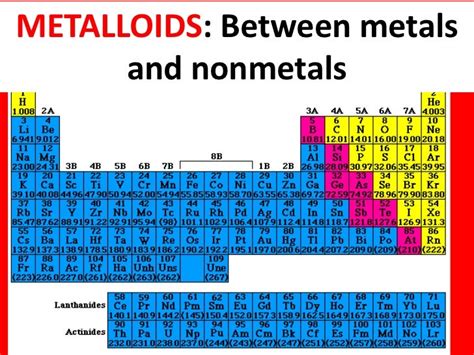Is Iodine A Metal Metalloid Or Nonmetal
listenit
Mar 31, 2025 · 4 min read

Table of Contents
Is Iodine a Metal, Metalloid, or Nonmetal? Exploring the Properties of a Halogen
Iodine, a fascinating element with a rich history and diverse applications, often sparks curiosity about its classification. Is it a metal, a metalloid, or a nonmetal? The answer, while seemingly straightforward, requires a deeper dive into its physical and chemical properties to fully appreciate its unique position in the periodic table. This article will explore iodine's characteristics, comparing them to the defining traits of metals, metalloids, and nonmetals, ultimately clarifying its classification.
Understanding the Classifications: Metals, Metalloids, and Nonmetals
Before delving into iodine's properties, it's crucial to establish a clear understanding of the characteristics that define each category:
Metals: A Symphony of Conductivity and Malleability
Metals are typically characterized by their excellent electrical and thermal conductivity, malleability (ability to be hammered into sheets), ductility (ability to be drawn into wires), and luster (shiny appearance). They tend to lose electrons easily, forming positive ions (cations). Metals are generally solid at room temperature (except for mercury), and they exhibit high melting and boiling points. Examples include iron, copper, and gold.
Metalloids: The Bridge Between Metals and Nonmetals
Metalloids occupy a fascinating middle ground, exhibiting properties of both metals and nonmetals. Their conductivity is intermediate, meaning they are semiconductors rather than excellent conductors like metals. They are often brittle and lack the malleability and ductility of metals. Their appearance can vary, and they can form both positive and negative ions depending on the chemical environment. Silicon and germanium are prime examples of metalloids.
Nonmetals: A Diverse Group with Varied Properties
Nonmetals are, in many ways, the opposite of metals. They are typically poor conductors of heat and electricity, lack luster, and are often brittle solids or gases at room temperature. They tend to gain electrons easily, forming negative ions (anions). Nonmetals exhibit a wide range of properties, making generalizations challenging. Examples include oxygen, chlorine, and sulfur.
Iodine's Properties: A Case Study
Now, let's examine iodine's properties in detail to determine its classification:
Physical Properties of Iodine:
- State at Room Temperature: Solid. Iodine exists as a dark gray, crystalline solid with a metallic sheen. This sheen, while resembling a metallic characteristic, is not indicative of metallic bonding.
- Conductivity: Iodine is a poor conductor of heat and electricity. This property immediately sets it apart from metals, which are excellent conductors.
- Malleability and Ductility: While iodine crystals can be crushed, they are brittle and lack the malleability and ductility characteristic of metals.
- Melting and Boiling Points: Iodine has a relatively low melting point (113.7°C) and boiling point (184.3°C) compared to many metals. However, these are not significantly low enough to definitively place it in the nonmetal category.
- Appearance: Iodine possesses a dark gray-black, lustrous appearance. This subtle metallic sheen can be misleading, as the lustre is not a result of metallic bonding.
- Density: Iodine is relatively dense compared to many nonmetals, but less dense than most metals.
Chemical Properties of Iodine:
- Ionization Energy: Iodine has a relatively high ionization energy, suggesting a reluctance to lose electrons. This behavior is more consistent with nonmetals.
- Electronegativity: Iodine has a relatively high electronegativity, indicating a strong tendency to attract electrons. This property is more characteristic of nonmetals.
- Oxidation States: Iodine exhibits variable oxidation states, a feature not exclusive to any one group but found prominently in nonmetals and some metalloids.
- Reactivity: Iodine is a moderately reactive element, readily reacting with many metals and some nonmetals to form ionic compounds. This reactivity is common among both nonmetals and some metalloids. However, its reactivity is far less than that of highly reactive nonmetals like fluorine or chlorine.
- Formation of Ions: Iodine predominantly forms negative ions (iodide, I⁻) by gaining an electron. This anion formation is a hallmark of nonmetals.
Conclusion: Iodine as a Nonmetal
Considering iodine's physical and chemical properties, it's clear that iodine is unequivocally classified as a nonmetal. While it possesses a few characteristics that might initially suggest a resemblance to metals or metalloids (like its lustrous appearance and moderate reactivity), the overwhelming majority of its traits align with the defining features of nonmetals: poor conductivity, brittleness, high electronegativity, a tendency to gain electrons and form negative ions. The metallic sheen observed in iodine is a result of its crystal structure and intermolecular forces and does not imply metallic bonding.
The fact that iodine readily forms negative ions (iodide) further strengthens its classification as a nonmetal. Its relatively high electronegativity highlights its ability to attract electrons, another key nonmetal characteristic.
While iodine's position in the periodic table within the halogen group might create some ambiguity, a thorough analysis of its properties leaves no doubt: iodine is a nonmetal. Its specific properties within the nonmetal category contribute to its unique reactivity and wide range of applications in various fields including medicine, industry and research. Understanding this classification is essential for comprehending its behaviour and applications. Further studies of iodine's reactivity, crystal structure and chemical bonding help solidify its place as a crucial member of the nonmetal family. It's a reminder that the periodic table, while a useful organizational tool, doesn't always perfectly capture the nuance of an element's behavior.
Latest Posts
Latest Posts
-
Why Did Small States Object To The Virginia Plan
Apr 02, 2025
-
What Is The Proper Name For Mgf2
Apr 02, 2025
-
Unit Of Measurement For Kinetic Energy
Apr 02, 2025
-
How Do Lichens Contribute To Primary Succession
Apr 02, 2025
-
Number Of Valence Electrons In Calcium
Apr 02, 2025
Related Post
Thank you for visiting our website which covers about Is Iodine A Metal Metalloid Or Nonmetal . We hope the information provided has been useful to you. Feel free to contact us if you have any questions or need further assistance. See you next time and don't miss to bookmark.
